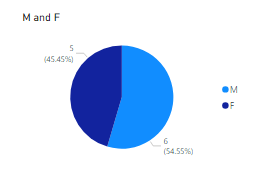FabCon is coming to Atlanta
Join us at FabCon Atlanta from March 16 - 20, 2026, for the ultimate Fabric, Power BI, AI and SQL community-led event. Save $200 with code FABCOMM.
Register now!- Power BI forums
- Get Help with Power BI
- Desktop
- Service
- Report Server
- Power Query
- Mobile Apps
- Developer
- DAX Commands and Tips
- Custom Visuals Development Discussion
- Health and Life Sciences
- Power BI Spanish forums
- Translated Spanish Desktop
- Training and Consulting
- Instructor Led Training
- Dashboard in a Day for Women, by Women
- Galleries
- Data Stories Gallery
- Themes Gallery
- Contests Gallery
- QuickViz Gallery
- Quick Measures Gallery
- Visual Calculations Gallery
- Notebook Gallery
- Translytical Task Flow Gallery
- TMDL Gallery
- R Script Showcase
- Webinars and Video Gallery
- Ideas
- Custom Visuals Ideas (read-only)
- Issues
- Issues
- Events
- Upcoming Events
Get Fabric Certified for FREE during Fabric Data Days. Don't miss your chance! Request now
- Power BI forums
- Forums
- Get Help with Power BI
- Desktop
- Applying filter on measure not working on visual p...
- Subscribe to RSS Feed
- Mark Topic as New
- Mark Topic as Read
- Float this Topic for Current User
- Bookmark
- Subscribe
- Printer Friendly Page
- Mark as New
- Bookmark
- Subscribe
- Mute
- Subscribe to RSS Feed
- Permalink
- Report Inappropriate Content
Applying filter on measure not working on visual piechart
I have a table XXX which has 4 fields:
ID, Gender, Startdate, Enddate
I created a measure YesNo which returns 0 or 1 when a selected date from a slicer lies beween startdate and enddate:
Measure YesNo =
var _datum=SELECTEDVALUE('Peildata'[datum])
return
if (
SELECTEDVALUE('Table'[startdate]) <= _datum
&&
SELECTEDVALUE('Table'[enddate]) >= _datum,
1,0)
When i present the results in a table visual it is correct
| ID | Gender | YesNo |
| 1 | M | 1 |
| 2 | M | 1 |
| 3 | M | 0 |
| 4 | F | 1 |
| 5 | F | 0 |
When I want to create a piechart visual which counts males/females, it gives me 3M and 2F, that is also correct.
But when I add the measure YesNo in the piechart visual filtering with YesNO is 1 and I expected to see 2M and 1 F
but my visual totally blanks and dissapears with no results
What does this not work?
Solved! Go to Solution.
- Mark as New
- Bookmark
- Subscribe
- Mute
- Subscribe to RSS Feed
- Permalink
- Report Inappropriate Content
Hi Yang,
Thank you very much. It puts me in the right direction. The solution is not have 2 separate measures
for the 2 genders, but teh folowing did the job:
The folowing measure works perfect:
Measure Headcount =
CALCULATE (
COUNTROWS ( 'Table' ),
'Table'[Startdate] <= SELECTEDVALUE ( 'Peildata'[datum] )
&& 'Table'[Enddate] >= SELECTEDVALUE ( 'Peildata'[datum] )
)
After further analysis of my data I discover that the ID field has duplicates, so to count only the
distinct values I wrote the folowing measure and it works just perfect!
Headcount =
CALCULATE
(
DISTINCTCOUNT(Tabel[ID]),
FILTER(Tabel,
Tabel[Startdate] <= SELECTEDVALUE (Peildata[Datum]) &&
Tabel[Enddate] >= SELECTEDVALUE (Peildata[datum])
)
)
Thank you very much for your assistence, much appreciated!!
Best regards,
Etiënne
- Mark as New
- Bookmark
- Subscribe
- Mute
- Subscribe to RSS Feed
- Permalink
- Report Inappropriate Content
Hi, eyeekit
May I ask if this is the expected output you are looking for? Based on your description, I have created two measures to achieve the effect you are looking for. Following picture shows the effect of the display.
Measure M =
CALCULATE (
COUNTROWS ( 'Table' ),
'Table'[Startdate] <= SELECTEDVALUE ( 'Peildata'[datum] )
&& 'Table'[Enddate] >= SELECTEDVALUE ( 'Peildata'[datum] )
&& 'Table'[Gender] = "M"
)
Measure F =
CALCULATE (
COUNTROWS ( 'Table' ),
'Table'[Startdate] <= SELECTEDVALUE ( 'Peildata'[datum] )
&& 'Table'[Enddate] >= SELECTEDVALUE ( 'Peildata'[datum] )
&& 'Table'[Gender] = "F"
)
If this does not work, could you please share some sample data without sensitive information and expected output.
How to provide sample data in the Power BI Forum - Microsoft Fabric Community
Best Regards,
Yang
Community Support Team
If there is any post helps, then please consider Accept it as the solution to help the other members find it more quickly.
If I misunderstand your needs or you still have problems on it, please feel free to let us know. Thanks a lot!
How to get your questions answered quickly -- How to provide sample data in the Power BI Forum
- Mark as New
- Bookmark
- Subscribe
- Mute
- Subscribe to RSS Feed
- Permalink
- Report Inappropriate Content
Hi Yang,
Thank you very much. It puts me in the right direction. The solution is not have 2 separate measures
for the 2 genders, but teh folowing did the job:
The folowing measure works perfect:
Measure Headcount =
CALCULATE (
COUNTROWS ( 'Table' ),
'Table'[Startdate] <= SELECTEDVALUE ( 'Peildata'[datum] )
&& 'Table'[Enddate] >= SELECTEDVALUE ( 'Peildata'[datum] )
)
After further analysis of my data I discover that the ID field has duplicates, so to count only the
distinct values I wrote the folowing measure and it works just perfect!
Headcount =
CALCULATE
(
DISTINCTCOUNT(Tabel[ID]),
FILTER(Tabel,
Tabel[Startdate] <= SELECTEDVALUE (Peildata[Datum]) &&
Tabel[Enddate] >= SELECTEDVALUE (Peildata[datum])
)
)
Thank you very much for your assistence, much appreciated!!
Best regards,
Etiënne
Helpful resources

Power BI Monthly Update - November 2025
Check out the November 2025 Power BI update to learn about new features.

Fabric Data Days
Advance your Data & AI career with 50 days of live learning, contests, hands-on challenges, study groups & certifications and more!


